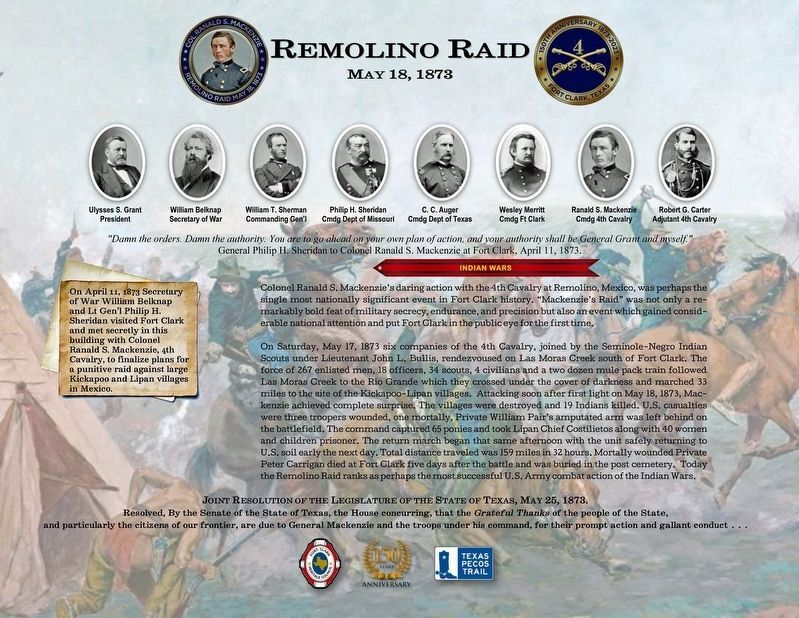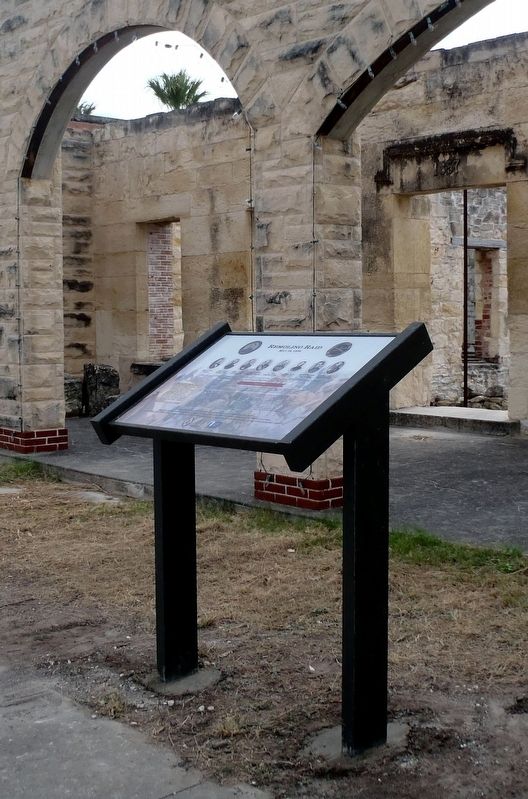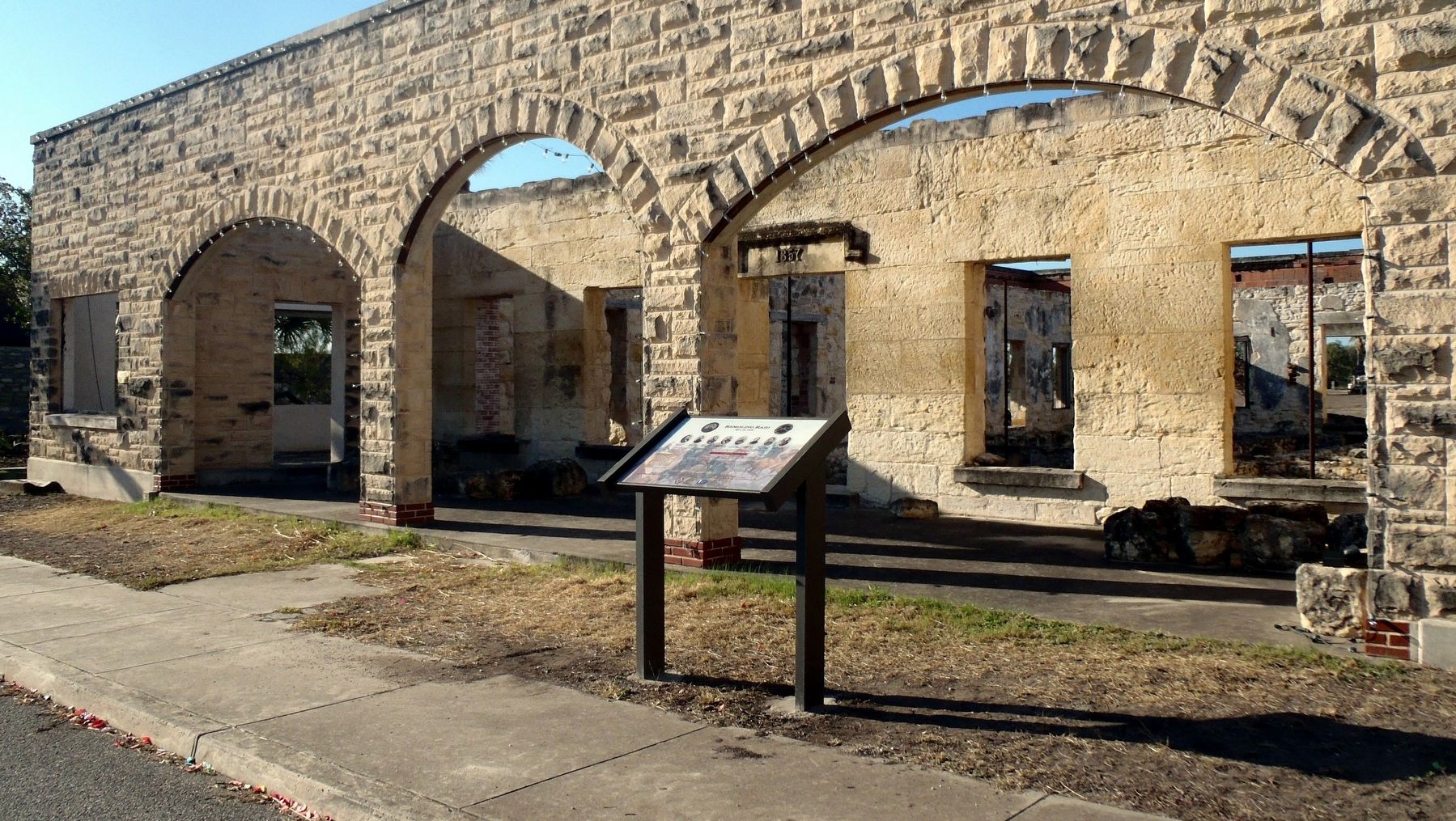Fort Clark Springs in Brackettville in Kinney County, Texas — The American South (West South Central)
Remolino Raid
May 18, 1873
Colonel Ranald S. Mackenzie’s daring action with the 4th Cavalry at Remolino, Mexico, was perhaps the single most nationally significant event in Fort Clark history. “Mackenzie’s Raid” was not only a remarkably bold feat of military secrecy, endurance, and precision but also an event which gained considerable national attention and put Fort Clark in the public eye for the first time.
On Saturday, May 17, 1873 six companies of the 4th Cavalry, joined by the Seminole-Negro Indian Scouts under Lieutenant John L. Bullis, rendezvoused on Las Moras Creek south of Fort Clark. The force of 267 enlisted men, 18 officers, 34 scouts, 4 civilians and a two dozen mule pack train followed Las Moras Creek to the Rio Grande which they crossed under the cover of darkness and marched 33 miles to the site of the Kickapoo-Lipan villages. Attacking soon after first light on May 18, 1873, Mackenzie achieved complete surprise. The villages were destroyed and 19 Indians killed. U.S. casualties were three troopers wounded, one mortally, Private William Pair’s amputated arm was left behind on the battlefield. The command captured 65 ponies and took Lipan Chief Costilietos along with 40 women and children prisoner. The return march began that same afternoon with the unit safely returning to U.S. soil early the next day. Total distance traveled was 159 miles in 32 hours. Mortally wounded Private Peter Carrigan died at Fort Clark five days after the battle and was buried in the post cemetery. Today the Remolino Raid ranks as perhaps the most successful U.S. Army combat action of the Indian Wars.
JOINT RESOLUTION OF THE LEGISLATURE OF THE STATE OF TEXAS, MAY 25, 1873. Resolved, By the Senate of the State of Texas, the House concurring, that the Grateful Thanks of the people of the State, and particularly the citizens of our frontier, are due to General Mackenzie and the troops under his command, for their prompt action and gallant conduct …
Erected 2023 by Fort Clark Heritage Council.
Topics. This historical marker is listed in these topic lists: Native Americans • Wars, US Indian. A significant historical date for this entry is May 18, 1873.
Location. 29° 18.346′ N, 100° 25.295′ W. Marker is in Brackettville, Texas, in Kinney County. It is in Fort Clark Springs. Marker is at the intersection of Patton Drive and Colony Row, on the left when traveling north on Patton Drive. Touch for map. Marker is in this post office area: Brackettville TX 78832, United States of America. Touch for directions.
Other nearby markers. At least 8 other markers are within walking distance of this marker. Married Officers' Quarters 8-9 (within shouting distance of this marker); Officers' Row Quarters (within shouting distance of this marker); Officers Quarters 2-3 and 4 (within shouting distance of this marker); Fort Clark Post Theater (about 300 feet away, measured in a direct line); 1873 Infantry Barracks (about 500 feet away); U.S. Army Unit Memorial (about 600 feet away); Seminole-Negro Indian Scout Detachment (about 600 feet away); Palisado Building Kitchen / Mess Room (about 600 feet away). Touch for a list and map of all markers in Brackettville.
More about this marker. Marker is located in front of the 1857 Post Headquarters Building. On April 11, 1873 Secretary of War William Belknap and Lt Gen’l Philip H. Sheridan visited Fort Clark and met secretly in this building with Colonel Ranald S. Mackenzie, 4th Cavalry, to finalize plans for a punitive raid against large Kickapoo and Lipan villages in Mexico.
Also see . . . The War to Exterminate the Lipan Apache (Lipan Apache Tribe).
Overview: By 1873, so many Texas settlers were complaining that the Lipans in Mexico were crossing the Rio Grande to raid in Texas that the U.S. military decided to take action. There were three Indian villages of the Kickapoo, Lipan, and Mescalero, respectively, a shor distance west of the Mexican village, El Remolino. On May 17, 1873, Col. Ranald Mackenzie ordered six companies of cavalry from Fort Clark to cross the Rio Grande River and attack the three rancherías. The first camp in the cavalry's line of march was the Kickapoo camp. All the warriors were away with only the elderly and women and children at the camp. Elderly Lipan chief Costalites was visiting the Kickapoo camp to trade goods. As the soldiers attacked the Kickapoo camp, the Lipan and Mescalero camps, which lay further away, were alerted and they managed to flee. Nineteen Kickapoo, though, were killed and forty Kickapoo women and children were taken prisoner along with Chief Costalites who was lassoed and dragged by a Seminole scout. Costalites later died when he tried to escape from a military "prison camp" at San Antonio.(Submitted on February 9, 2024, by Andrew Ruppenstein of Lamorinda, California.)
Credits. This page was last revised on February 9, 2024. It was originally submitted on February 8, 2024, by William F Haenn of Fort Clark (Brackettville), Texas. This page has been viewed 55 times since then. Photos: 1, 2, 3. submitted on February 8, 2024, by William F Haenn of Fort Clark (Brackettville), Texas. • James Hulse was the editor who published this page.


